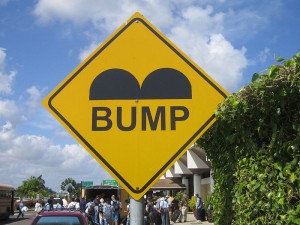 In Montana there is a bit of an unspoken rule when dealing with warning signs along roadways. The further in advance the placement of the warning sign from the road condition for which it warns, the smaller the occurrence of that particular road condition.
In Montana there is a bit of an unspoken rule when dealing with warning signs along roadways. The further in advance the placement of the warning sign from the road condition for which it warns, the smaller the occurrence of that particular road condition.
For example: If you are motoring down highway 93 and you spot a sign warning you of an imminent “Bump” at the same time you spot an irregularity in the pavement no further than fifty feet past the sign, then you best hit the breaks. ‘Cause it’s gonna’ be a doozy. On the other hand, if you fail to see any irregularities in the road what so ever until you have driven another mile, then you can ignore the warning all together. A bump a mile after the warning will end up feeling like nothing more than a pimple of asphalt beneath your tires.
I’ve been wondering if this is how sign posts and warnings should work in real life and good story as well. While in real life I have a tendency to ignore signs all together, in the telling of story I endeavor to lay out the whole map of twists and turns in advance. I suppose either extreme is a bit, how do I put this gently? Stupid.
Sure, most warning signs are filthy, rotten liars. We’ve all driven around enough “35 mph” curves at 50mph to know this. Montana drivers have slowed for pimples of asphalt as far as three miles down the road from “bump” signs just to wonder why they bother slowing down at all. But then the next day they straddle an axle snapping trench, their face empillowed with airbag, ten yards past the same sign and they remember why.
Just because most “stop” signs peppering country byways are ridiculous, doesn’t make running all of them a good policy. But I’m starting to realize that telling stories using the opposite extreme isn’t any wiser. Who wants to know they’ll be making a left turn at 35 mph in twenty five miles? (Unless you’re going 2500 mph, in which case you’d be turning left in about 40 seconds and you need to slow down by 2465 mph, give or take 15 mph.)
It’s a hard balance I’m still trying to learn. After all, most people want to look at a map before they begin an adventure. But only weirdos zoom in on the route via google earth and follow it at the highest magnification possible from beginning to end beforehand (I’ve only done it once, I swear. And I’m too stupid to remember more than a few turns anyway). Maps and signposts are good both in life and in story, but they do different things.
Maps should be given far in advance and provide vague direction (yes, I’m a man). Signposts should come only right before an event (a plot point or a real life occurrence), and on second thought, they shouldn’t lie any more than absolutely necessary to make life fun.
And I suppose potholes are around just to be little reminders that sh$% happens.